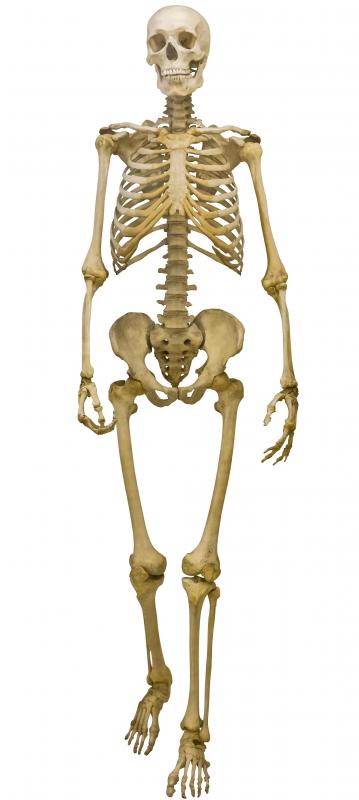At TheHealthBoard, we're committed to delivering accurate, trustworthy information. Our expert-authored content is rigorously fact-checked and sourced from credible authorities. Discover how we uphold the highest standards in providing you with reliable knowledge.
What is Cortical Bone?
Cortical bone is a compact type of bone tissue. This type of bone is denser than other types and accounts for up 80 percent of the weight of a human’s skeleton. It is mostly present in the shaft portion of a person’s long bones, such as the bones found in the arms and legs. Additionally, the outer shell found around the spongy bone at the end of the joints is made up of cortical bone.
There are two bone tissue categories. Cortical bone makes up one category while cancellous bone, which is spongy interior bone tissue that makes up 20 percent of the human skeleton’s weight, is in the second category. It has a much higher density than cancellous bone, but it is less porous, with a porosity level that ranges from five to 10 percent in comparison to cancellous bone’s 50- to 90-percent porosity range. This means compact bone has fewer spaces and cavities than spongy bone. Despite these differences, compact and spongy bone tissue work together, as cortical tissue is the shell that covers the cancellous bone of the vertebrae and joint ends.

To understand how cortical and cancellous bone work together, it helps to consider the thigh bone or femur. The upper end of this bone consists of the spongy tissue of cancellous bone, which acts as a shock absorber for the bones and helps to provide stability. The shaft of the femur, however, consists of cortical bone tissue that helps the bone to be resistant to bending, especially in places where bone bending could be particularly problematic, like the middle of the bone. Blood vessels and nerves weave through both bone types.

A membrane called the periosteum covers cortical bone. Periosteum is both fibrous and dense and covers most bones. It rests on top of the bone tissue and provides a place for muscles and tendons to attach to the bone's surface. The periosteum also has another important job. It houses capillaries that transport blood to the bone tissue.
Some cortical bone tissue is lamellar, which is layered, strong, and formed by parallel fibers. Other cortical bone tissue is woven and forms quickly when bone tissue is growing or being repaired. It is not as strong as lamellar bone because its fibers are randomly aligned. Frequently, lamellar bone tissue replaces bone tissue as bone matures.
AS FEATURED ON:
AS FEATURED ON:
















Discussion Comments
I have a question -- so I know that cortical bone is the hard bone, but what would be some factors that affect cortical bone strength?
I have been seeing a lot of articles talking about losing density of bone, and I would assume that would also mean a loss of bone strength, but I'm afraid I'm a bit fuzzy on how it all works.
Does bone density actually apply to cortical bone, or is it only to cancellous bone? And what would be some ways to increase your bone density? It it possible to have too high a bone density, if it's possible to have a too low bone density?
Thanks for your help.
I have had a friend who was recently diagnosed with bone lesions, specifically an enchondroma, and I was wondering if anybody could tell me a little more about that condition.
When we went to the doctor he just said a lot of complicated stuff about bone remodeling and ossification, so we weren't really sure what he was on about.
Can anybody tell me in short sentences with small words what exactly is going on with bone lesions?
Very cool -- I have been browsing around looking for information about bone structure and health since I'm getting older and need to be taking care of these things, and this article was very informative and helpful.
For instance, I had no idea that the physiology of bone was so detailed -- like that covering, the periosteum. That was a new one to me, but very, very interesting.
Thanks for the good work1
Post your comments